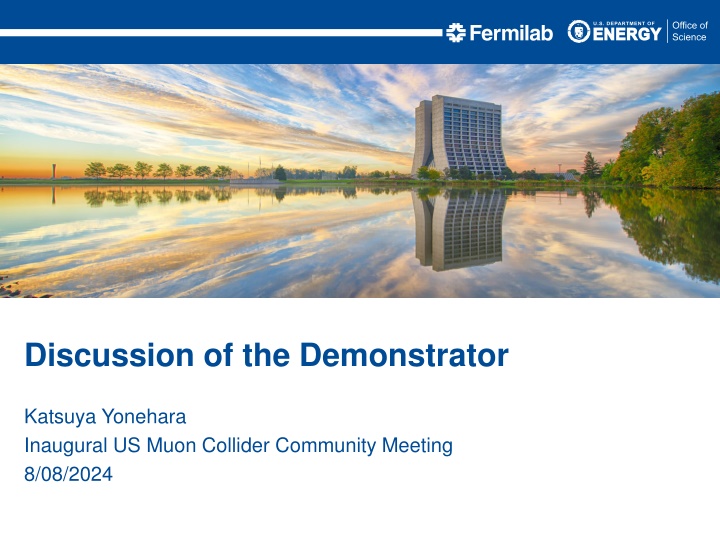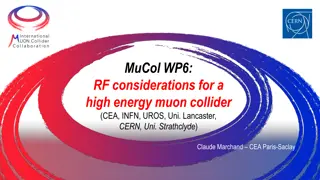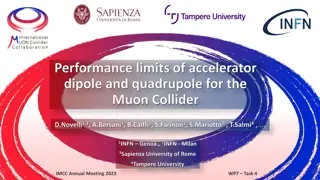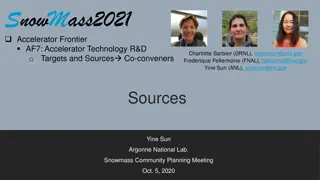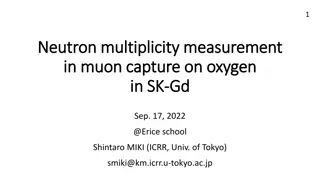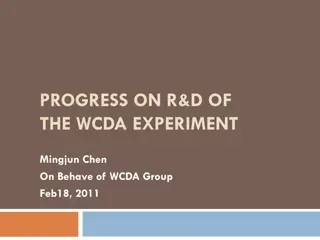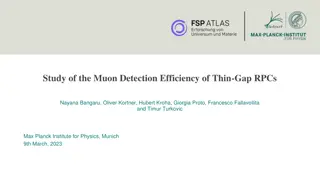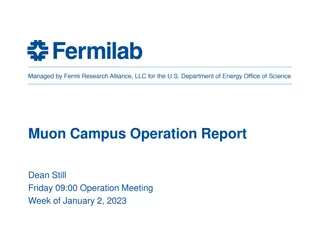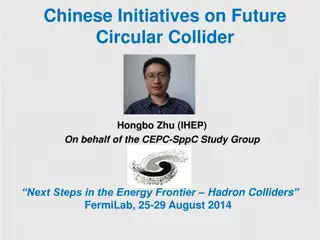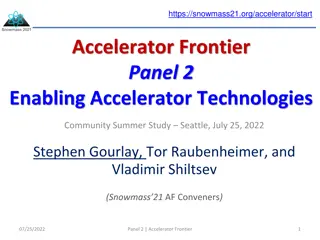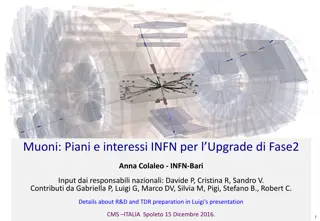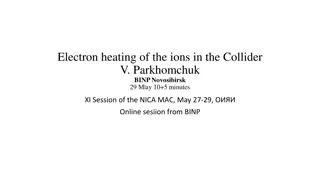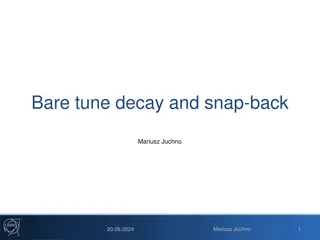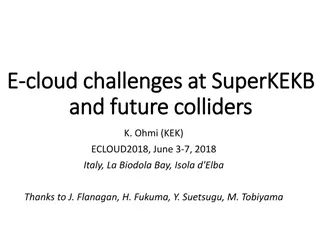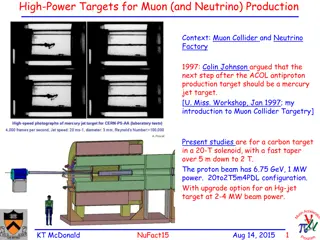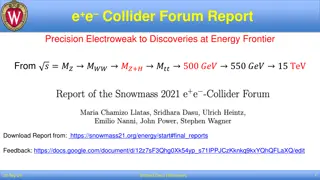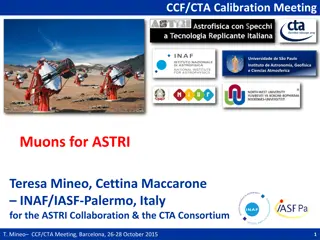Developments in Muon Collider Technology at the Inaugural US Muon Collider Community Meeting
Discussion at the US Muon Collider Community Meeting highlighted advancements in muon accelerator technology, with a focus on the Demonstrator by Katsuya Yonehara. Key topics included the layout of the muon accelerator complex, achievements in ionization cooling, and the MERcury Intense Target. The presentation also touched on possible targets and capture methods for muon collider applications. Collaborative efforts and R&D initiatives aim to drive progress in muon collider research and development.
Uploaded on Sep 24, 2024 | 3 Views
Download Presentation

Please find below an Image/Link to download the presentation.
The content on the website is provided AS IS for your information and personal use only. It may not be sold, licensed, or shared on other websites without obtaining consent from the author.If you encounter any issues during the download, it is possible that the publisher has removed the file from their server.
You are allowed to download the files provided on this website for personal or commercial use, subject to the condition that they are used lawfully. All files are the property of their respective owners.
The content on the website is provided AS IS for your information and personal use only. It may not be sold, licensed, or shared on other websites without obtaining consent from the author.
E N D
Presentation Transcript
Discussion of the Demonstrator Katsuya Yonehara Inaugural US Muon Collider Community Meeting 8/08/2024
Layout of muon accelerator complex for colliders Number of muons per bunch The achievable collider luminosity depends on the performance of the Front- End and Cooling sections =??+ ?? ? ?? 4? ?? ?? Beam spot size at collision point Scope of the demonstrator: Can the realistic machine achieve the designed ? and ?? 2 2/23/24 Targetry R&D for US MC, Yonehara
IMCC is the front runner of the Demonstrator design While the physics of ionization cooling has been shown it is critical to benchmark a realistic MuC cooling lattice. C. Rogers x5 Aim Demonstrate 6D cooling in multiple cooling cells, an advanced technology derived from MICE (adding reacceleration and dispersion) Engineering integration of high gradient RF cavity and absorber in strong solenoid magnets US Muon Collider Community will join IMCC and support the demonstrator program 3 12/14/23 muIC 2023, Target and Cooling, Yonehara
Highlight of MERcury Intense Target (MERIT) Layout of MERcury Intense Target (MERIT) 1 cm Proof-of-principle demonstration of a free Hg jet target for a 4-MW proton beam, contained in a 15-T pulsed solenoid The yield measurement of the secondaries was performed (without PID) Liquid metal target will survive with 1014-15 protons impact 4 2/23/24 Targetry R&D for US MC, Yonehara
Possible Demonstrator Target and Capture The liquid (powder) metal target has potential for use as a muon collider target A few R&D steps are needed to be ready for use 20-Tesla capture solenoid + rad shielding is quite expensive No real targetry R&D can occur until proton driver is available IMCC has developed a simplified version of target and capture sections using well-established technologies P.B. Jurj et al. IPAC 24, MOPR03 Use a magnetic horn and graphite target, as employed in neutrino experiments A recent magnetic horn study shows that a horn forms a FODO channel, which will focus both charged pions 5 2/23/24 Targetry R&D for US MC, Yonehara
Concept of ionization cooling channel Heat transfer from hot object to cold one Beam Absorber Heat flows when q (momentum)-transfer via coulomb interaction ????? 2 ??> ???? 2 ? 2?=??? 2 Equilibrium condition ?? ~ ???? Beam temperature is maximum at a focusing point in a beam optics Optics is set near resonance ? a: maximum beta function (RF cavity) c: minimum beta function (absorber) 6 2/23/24 Targetry R&D for US MC, Yonehara
End-to-End MAP Frontend & Cooling simulations 4a) 6D cooling channel (peak Bz 14 Tesla) Yellow: Solenoid coil Magenta: Absorber Red: RF cavity 5a) 4D cooling channel (30 Tesla solenoid) 7 2/23/24 Targetry R&D for US MC, Yonehara
International Muon Ionization Cooling Experiment Peak field 2 Tesla at absorber P.B. Jurj doctoral thesis MICE is designed for measuring ~10 % emittance reduction within 0.1 % accuracy To this end, MICE use a single particle tracking Red: Solenoid coil Green: Absorber Blue box: Tracker space Nature Physics, July 2024 No absorber data: No initial emittance dependence ? slightly high due to heating at beam windows Crossing a blue line and zero ? corresponds to the equilibrium emittance (2.5 mm): MICE reports there is a mismatching in the optics which causes emittance growth LiH data: Larger initial emittance makes larger cooling effect MICE demonstrates the achievable emittance Initial transverse muon beam emittance 8 2/23/24 Targetry R&D for US MC, Yonehara
Highlight of Cooling RF cavity test at MTA Peak gradient in vacuum RF 201 MHz MICE cavity 3-Tesla solenoid Measurement Prediction Observed peak gradient in gas-filled RF + 3 Tesla Beam loading 9 2/23/24 Targetry R&D for US MC, Yonehara
Sketch R&D Timeline S. Jindariani Orange font item related to Demonstrator set up three main subjects Proton driver design R&D Muon cooling design Muon Collider Ring design Machine Design R&D Fermilab Task Force Targets and Capture Magnets RF Technology SRF Technology Bunch Compression (for proton beam) Machine Technology R&D Demonstrator 10 2/23/24 Targetry R&D for US MC, Yonehara
Phase approach for the Demonstrator D. Stratakis, IPAC 24 WECD3 Advanced RF technology to operate RF cavities in magnetic fields Develop RF power source Develop beam instrumentation and emittance monitor to study 6D emittance evolution along channel 11 2/23/24 Targetry R&D for US MC, Yonehara
Consider Final Cooling Channel The exceptional cooling requires advanced accelerator science and technologies High field magnets Extend rectilinear channel using HTS magnet > 30 Tesla solenoid channel New cooling concept Reverse emittance exchange Parametric resonance Ionization Cooling Plasma focusing cooling These schemes will be investigated as part of the machine design R&D and the machine technology R&D Prototype final cooling channel(s) and run the cooling demo test in the later stage of the demonstrator period 12 2/23/24 Targetry R&D for US MC, Yonehara
Summary Focus on the Front End and Cooling sections as the Demonstrator The performance of these channels is crucial in determining the achievable collider luminosity Understand beam options, and control matching and correction components for stable operation Several critical machine technology R&D projects have been completed in the past We are ready to collaborate with IMCC to develop the demonstrator design and prototype the components Identify a physics driver using a high brightness muon source 13 2/23/24 Targetry R&D for US MC, Yonehara
Ideal muon source for the demonstrator Alternative design: Cold muon beam from surface pion decay 25 No ionization cooling channel is needed! Cost of the + source is ~$40M 14 12/14/23 muIC 2023, Target and Cooling, Yonehara
